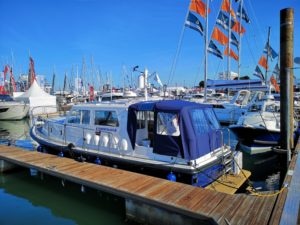America’s Cup: Hearing for bases takes just seven hours
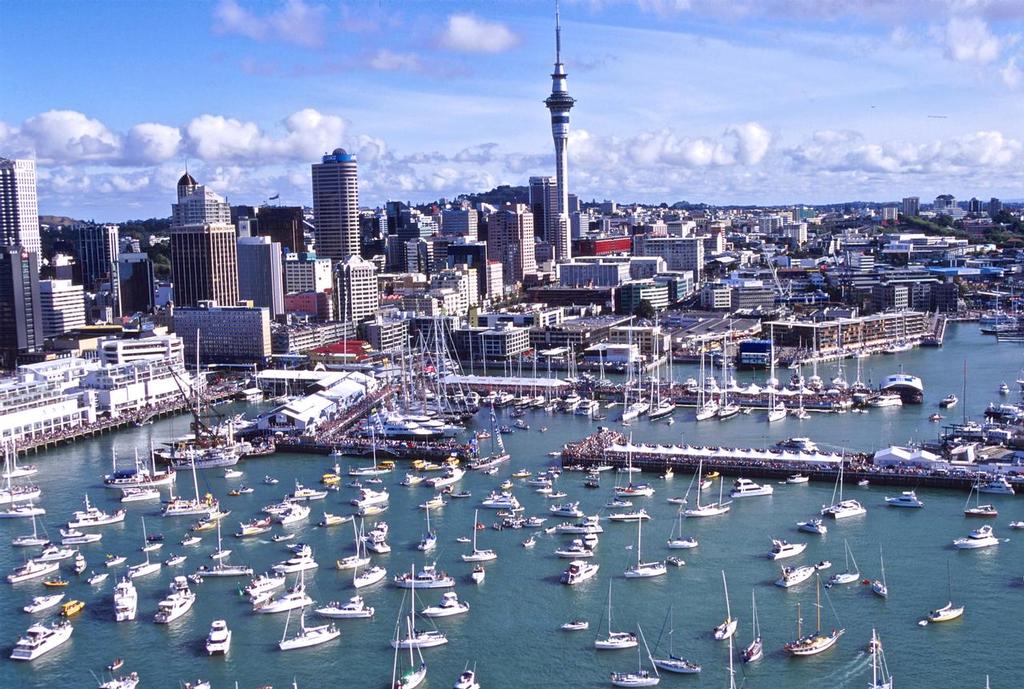

Emirates Team New Zealand sails past the America’s Cup Village in San Francisco © Richard Gladwell
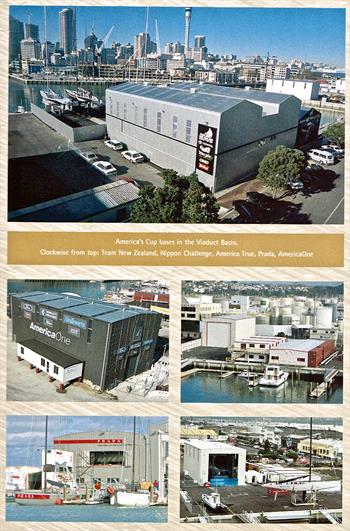
Mosaic of 2000 America’s Cup bases in Auckland – the 36AC building restrictions apear to be predicted around this style of building © Imageworks
The Environment Court has finished a Hearing of the Resource Consent Application necessary to obtain permission to construct new America’s Cup facilities in Auckland.
Expected initially to last two-three weeks, the Hearing before a Panel of two judges and three Commissioners took just seven hours spread across one and a half days, with almost all parties generally supporting the Application.
The 36th America’s Cup will be the first to return to a venue of a previous holder. Unfortunately for Auckland the facilities developed around the Viaduct Harbour have been sold off as corporate office, apartment and hotel facilities, and the City has to repeat the project championed by Sir Peter Blake after the America’s Cup win in 1995.
After an acrimonious nine months following the win in Bermuda, the political decision was made by the Auckland Council and Labour-led coalition Government to re-develop Wynyard Point, after the removal of tonnes of decommissioned fuel and hazardous substances tanks in a project estimated to cost in excess of NZD$200 million.
The New Zealand Government will shoulder the majority of the costs. For its part Auckland Council through its property development arm, Panuku Developments, has bought forward $50million of planned expenditure and contributed $50million of new money for the development.
The America’s Cup infrastructure spend is partially offset and justified by planned expenditure for APEC – which will be held in Auckland in November 2021, and for which almost $300million of expenditure had been signalled.
With fresh memories of the development in the area which has been ongoing for 20 years, the early meetings of the Hearing process was a near standing room only affair with a mix of lawyers, planners, engineers and related professions representing affected and interested parties.
By a casual estimate the sessions were generating professional billings of an eye-watering $100,000 per day.
But their masters received a payback with the 2-3 week Environment Court Hearing and ancillary engineering, planning and legal being reduced significantly to an amicable seven hour Hearing.
To achieve the required construction deadlines, Panuku Developments elected to shorten the Resource Consent hearing process by referring the matter directly to the Environment Court presided over by well known Auckland yachtsman and Principal Environment Judge, Laurie Newhook.
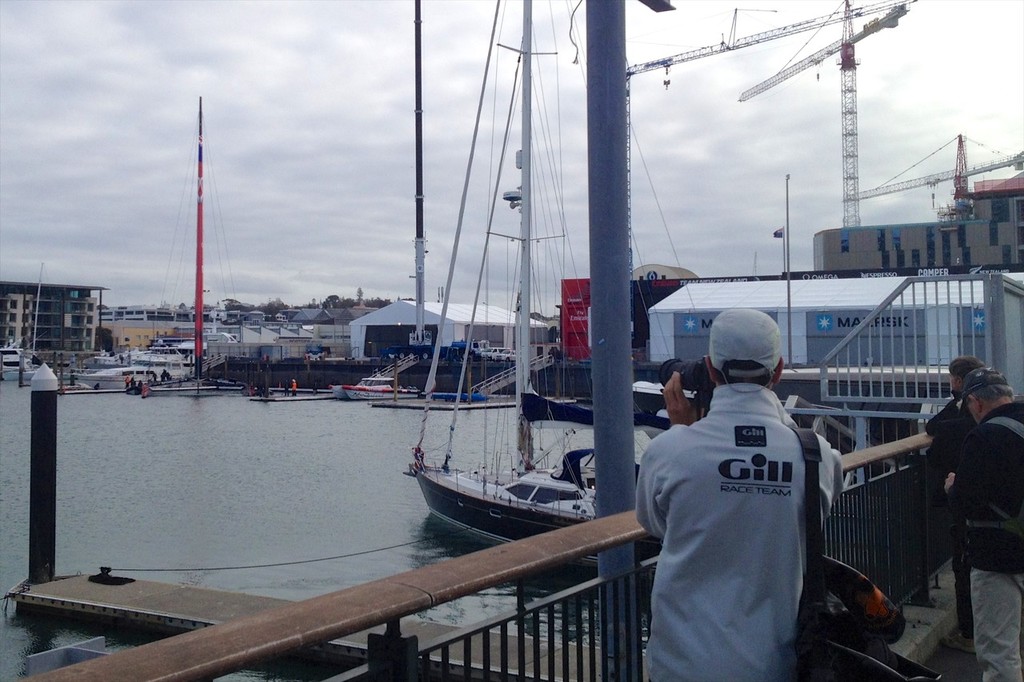
A spy from one of the teams plies his trade with a long lens waiting for ETNZ’s AC72 to pass by July 21, 2012 © Richard Gladwell www.photosport.co.nz
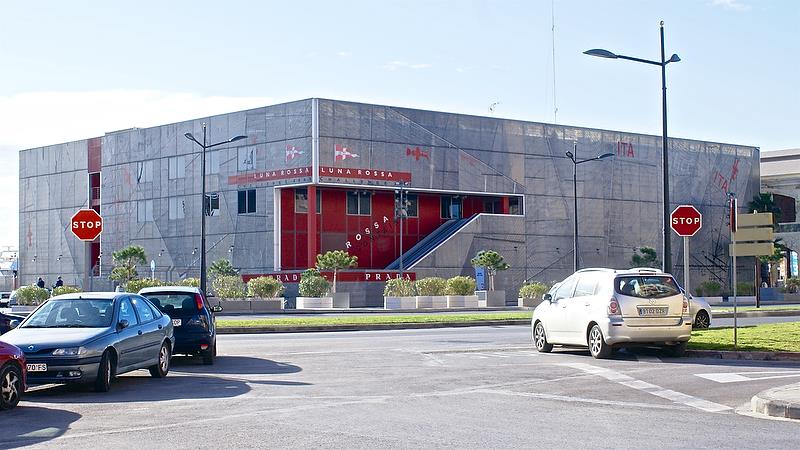
The stylish Luna Rossa base in Valencia at the time of the 2010 America’s Cup – photo © Richard Gladwell
The Court ordered the 41 Interested Parties to commence a Mediation Process guided by two Commissioners to identify and resolve their issues as best they were able – to reduce the workload on the Court in what is a very complex case.
Negotiations between the parties continued right up to the start of the formal Environment Court Hearing on Monday, with most issues being resolved and awaiting the approval of the Court.
In closing the Hearing before lunch on the second day, Principal Judge Newhook paid tribute to the enormous amount of work done by all parties, which had “put the Court in the position where it has conducted one and a half days of hearing where two weeks were estimated previously and were considered by us to be very likely to be needed at one point. So the parties are to be congratulated. It’s made the work of the Court in a large and complex matter considerably more straightforward, and the decision of course will be reserved – but it should be capable of being delivered within a very few weeks and not months, which might assist timelines going forward.
“I have virtually now indicated what the answer will be, but that’s been becoming apparent since particularly Friday afternoon and as we worked through matters in the courtroom yesterday and today,” he concluded.
Over 3500 pages of evidence was produced during the Hearing, which is considered by the Panel, during the course of making their Decision which is expected in October.
The Design Requirements for the America’s Cup bases are the major issue remaining in dispute between the parties, with Panuku Developments and Emirates Team New Zealand eventually signing off on the requirements with the Challenger of Record withholding their consent on some key points.
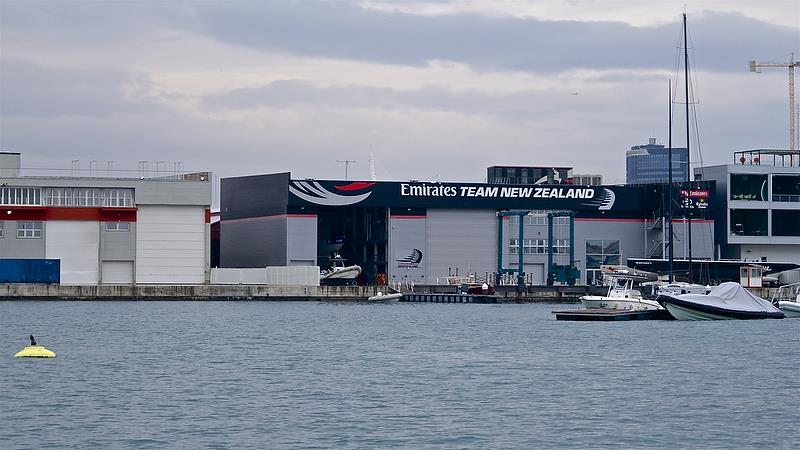
Emirates Team New Zealand base in Valencia at the time of the 2010 America’s Cup was the only base that did not use a standard steel framework – photo © Richard Gladwell
The first of these relates to signage that the teams will be permitted to display, with the maximum size being 40% of any base facade. In a similar vein Mirko Groeschner, for the Challenger of Record was uncomfortable with the restrictions being placed on building design which he claimed “negates the opportunity to express their own creativity and flair” in the building architecture. [Read his final response https://www.environmentcourt.govt.nz/assets/Documents/Publications/E104-Mirko-Groeschner-RE-Challenger-of-Record-AC36.pdf]
What created a few quizzical looks from those familiar with the America’s Cup is that a group of urban designers and landscape architects would seek to impose constraints on the style of Prada, one of the world’s leading high-fashion houses, in their team’s base design.
Under the finally negotiated base plan, the Prada backed Challenger of Record, Luna Rossa is allocated “Base B” on an extension to Hobson Wharf – which will have a consent life of 35 years.
The expectation is that a permanent base will be built on the site which is also the closest to residential apartments on nearby Princes Wharf.
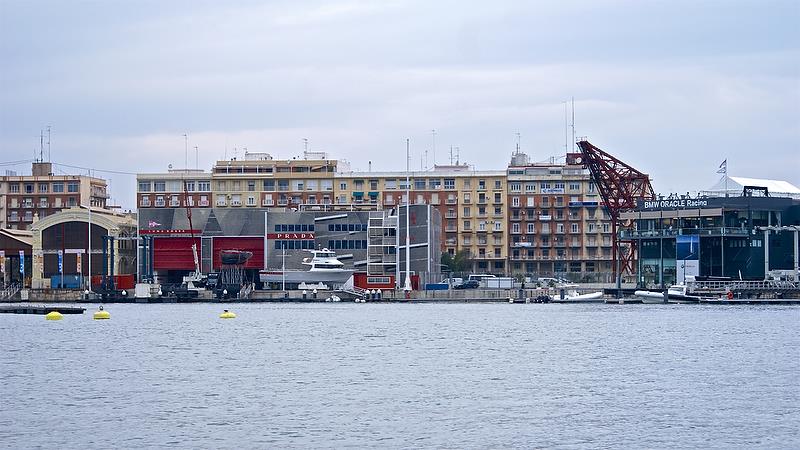
Luna Rossa base in Valencia at the time of the 2010 America’s Cup – photo © Richard Gladwell
Unfortunately, the memories of Aucklanders are of the uninspiring base design used in the 2000 and 2003 America’s Cups and did not want a repeat in the Luna Rossa base. The Court will have to decide on this issue.
A serious issue for the Challenger of Record and the Challenging Teams is the requirement in the Application Requirements is for substantial areas of “clear glazing” to allow the public (including team spies) to look directly inside the team buildings and see the activities and boats inside.
If approved by the Court, this will be the first time such a requirement will apply in the America’s Cup, where normally the boats are taken quickly inside, and all work takes place in secrecy.
Although not raised as a specifically by the Challenging teams the fact is is that the bases are surrounded by easy vantage points, and in recent editions of the Cup the long lenses of Cup spies have been focussed on the Team New Zealand base, hoping to catch an inadvertent open door, and getting an early view of design development.
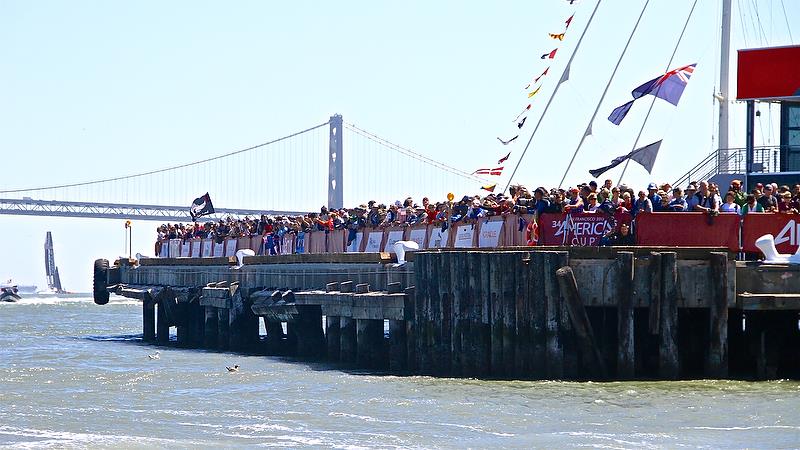
Fans are expected to crown vantage points on wharves around the Auckland America’s Cup bases, as the did in San Francisco – photo © Richard Gladwell
Originally the requirement was Ground floor glazing/windows was set to be 60% of one of the sides of the Luna Rossa base on Hobson Wharf and 100% of the length of the western side of the other bases to allow what is quaintly termed “passive surveillance”.
These percentages were subsequently reduced to 30% for Luna Rossa and 33% of the base width for the remaining bases. Quite what triggered this “passive surveillance” requirement was never made clear.
While the Protocol Provisions on Reconnaissance have been reduced from the strictures of previous America’s Cup provisions, it is unlikely that the teams contemplated a situation where they could be working on a boat watched and photographed by their competitors peering through the Council specified window.
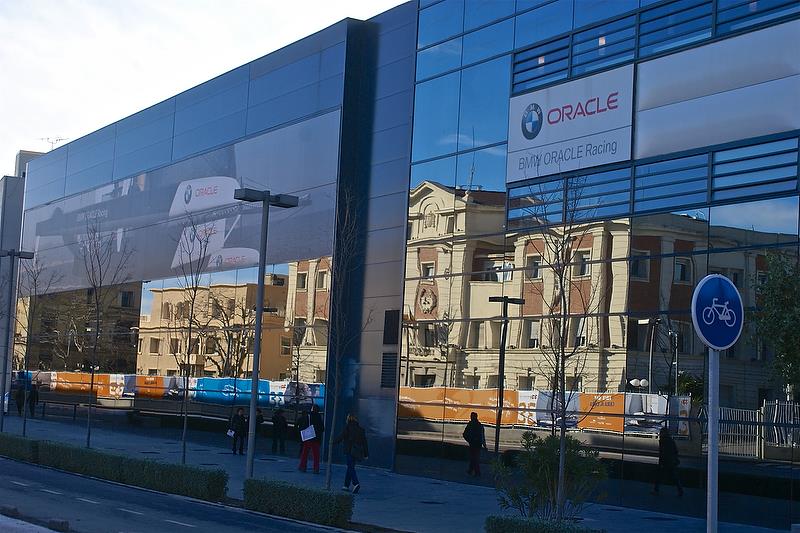
BMW Oracle Racing’s base in Valencia made extensive use of reflective glass which is proposed to be banned in New Zealand – photo © Richard Gladwell
One of the parties in the Court Hearing noted that the New York Yacht Club would have loved to have had this provision in the 1983 America’s Cup, so they could see into the Australia II shed and what was really happening with the winged keel, when it was being fitted!
The requirement to allow “passive surveillance” ignored the fact that usually, America’s Cup teams are highly secretive to maintain a design and development edge, and whether the teams were happy to have the public/fans and spies peeping into the base was not mentioned.
Again this is a further issue on which the Court will have to rule. All parties have indicated they will accept the Courts decision on this matter, and will not Appeal.
Emirates Team New Zealand is to one side of the Consent process, as it will be occupying the three-level Viaduct Events Centre in the centre of the America’s Cup venue.
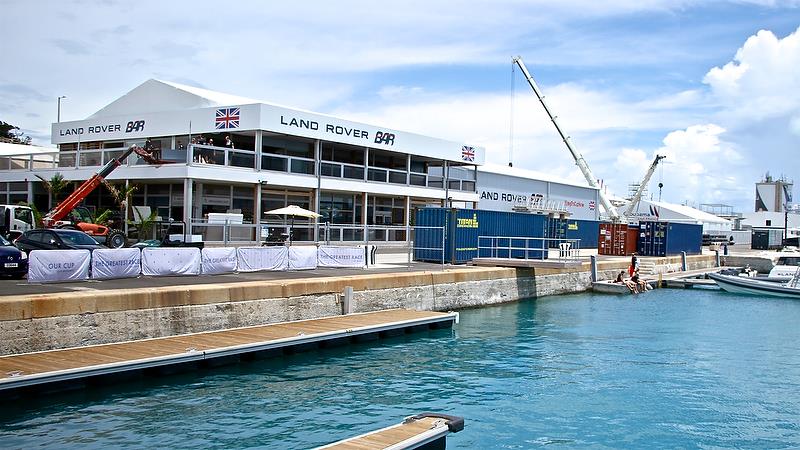
Pop up or prefabricated bases were used in the 2017 America’s Cup – photo © Richard Gladwell
The long-term fate of the land to be re-developed on Wynyard Point is currently in limbo. The Court made it clear that it could only impose conditions which had a ten-year window – being the duration of the Application. However, the Ministry of Business, Innovation and Employment (NZ Govt) in its submission made it clear that they wanted as few barriers as possible to encourage smaller teams and late entering teams into the America’s Cup. They added that “the Crown does not wish to see Auckland in this position again in 15 years’ time as a result of Wynyard Point and/or the wharves being developed in a manner that forecloses the future hosting of similar events.”
It would seem that the Government will have to legislate to achieve its goal.
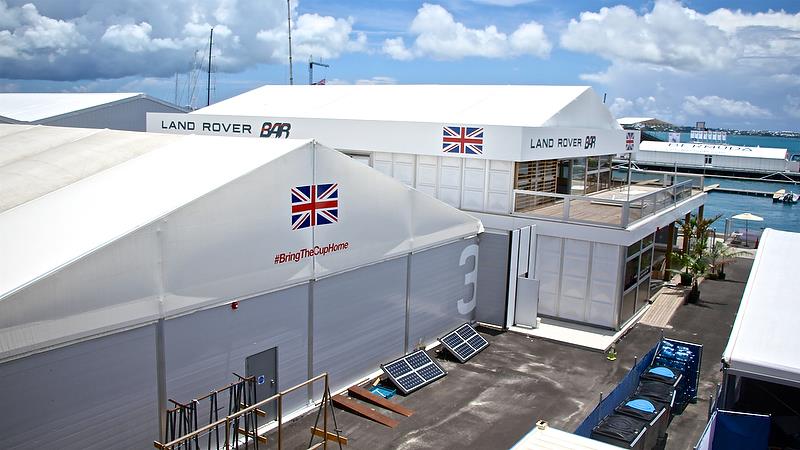
Land Rover BAR had a mix of two boat hangars and a team hospitality area in Bermuda – photo © Richard Gladwell
Not to be outdone by the America’s Cup milestone in Auckland, the New Zealand Parliament passed the first piece of legislation relating to the America’s Cup, through all three stages late on Tuesday afternoon. In a very rare show of unanimity, the legislation to enable the closure of a portion of Brigham Street on Wynyard Point was supported without reservation by the four political parties. Further, the debate was foreshortened from the scheduled 12 speeches to just four – one from each Party in support.
The Minister, David Parker on speaking to the Bill commented that: “There are also provisions that are being sought by the Crown to enable the continued open nature of this site, so that future America’s Cups or some other equivalent event in the future can be held on that open site – and that we don’t have to go through this palava again to create open space on the Auckland Waterfront for these sort of Events.’
At the time of speaking to the Bill, Minister Parker did not make any comment as to whether the Government would also have to legislate further to give effect to the Crown’s stated intention for the land occupied by the America’s Cup bases.

The area developed for America’s Cup Bases and Teams for the 2000 and 2003 America’s Cups has been taken over for other property development and new facilities are required for the 2021 Defence. They will be located on Hobson Wharf and Wynyard Point to the right (and out of shot) in this image. – photo © Bob Greiser/America’s Cup
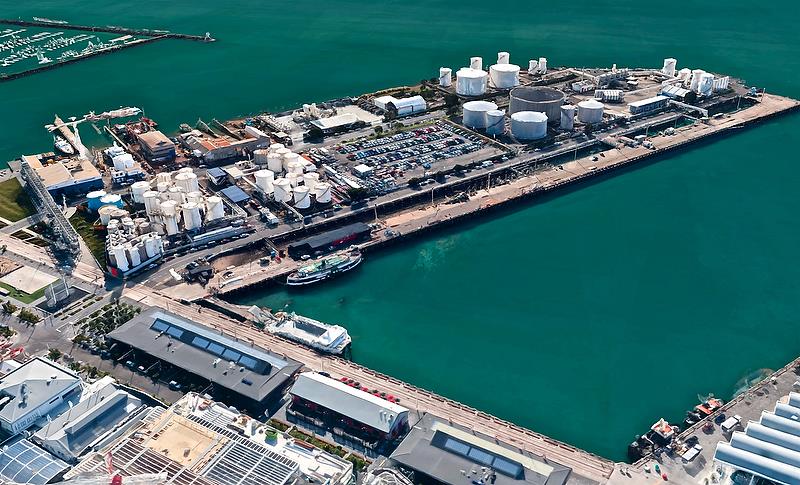
The Wynyard Point area will be half cleared of tanks to create an area for the America’s Cup bases in Auckland. – photo © Richard Gladwell
Story by by Richard Gladwell, Sail-World.com/nz



